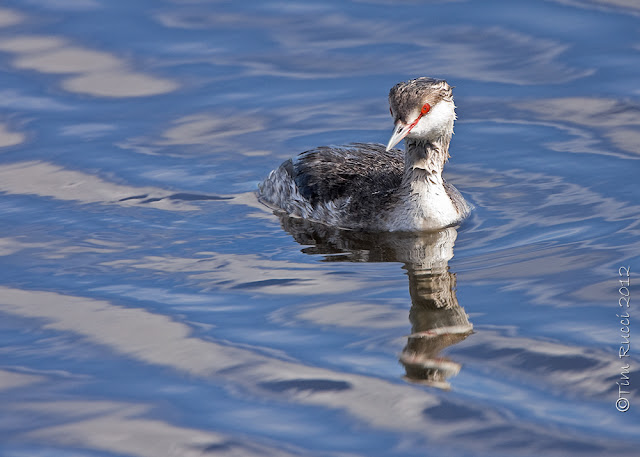I was glad to be able to make my first trip of the season to Merritt Island National Wildlife Refuge earlier this week, and fortunately there were enough birds to make the trip worthwhile. It's about 150 miles away, so I have to start out around 4:45 am in order to get there by sunrise and take advantage of the soft early morning light.
I was able to photograph a couple new species on this trip so that was an extra bonus. This time of year the birds are starting to dawn their breeding colors, so that makes the photography all the more rewarding. I met up on this trip with
Dave Turko and we spent the morning tooling around Blackpoint Drive and Biolab Road, within the refuge.
 |
| #111890 - Reddish Egret - 1/1250 @f4, iso 400, 500mm |
We saw quite a few reddish egrets, and enjoyed watching them strut around in the shallow water and pounce on countless fish. They always put on a good show. The image above shows a typical early morning scene. Below, the bird is ready to strike at a fish, and they rarely miss.
 |
| #111990 - Reddish Egret - 1/800 @f8, iso 400, 1000mm hand-held |
 |
| #111873 - Reddish Egret with Catch - 1/1250 @f4, iso 400, 500mm |
One species I have rarely seen and had never photographed, is the white morph reddish egret. We were fortunate to see one but not in the best light. I did not manage to get a photo I was happy with, but I captured the image below as documentation of having seen it.
 |
| #111906 - White Morph Reddish Egret - 1/2500 @f5, iso 400, 500mm |
The white morph is one of the most beautiful birds I've ever seen. I'm pretty sure the color of the bird's bill and lore get brighter than you see here. I hope to be able to get some better images of this species at a later time.
The image below is a Northern Shoveler. They are common but I had not gotten a decent photo of one before now.
 |
| #111951 - Northern Shoveler - 1/1250 @f8, iso 400, 1000mm hand-held |
This is the first time I've tried hand holding my camera with 500mm lens and 2x teleconverter attached. Adding the flash, the entire rig weighs 15 pounds. It's quite a bit of weight to try and hold steady to get sharp photos. I've gotten used to stooping down and propping up the lens with my left arm, resting it against my knee for support. Dave shot this photo of me holding this rig. When time permits, it's a lot less work to mount it on a tripod with gimbal head.
One thing that really surprised me was that the images shot with the 2x teleconverter on this outing were surprisingly sharp. Many times in the past I have avoided using the 2x except occasionally on my 300L f2.8 and 500L f4 lenses, and even then only as a last resort. In theory, an extender will degrade image quality slightly, so you only want to mount it if you are using a very high quality lens to start with. I sent my 500 f4 to Canon to have the calibration checked a few months back and this outing indicates that it's performing noticeably better now. Before calibration, the images were noticeably softer with a teleconverter attached, than what I am getting now.
 |
| Canon 1D Mk2N camera, Canon 500L f4 IS lens, 2x Teleconverter, and 580EX II flash with "better beamer" flash extender |
The next two images are a horned grebe. I had seen this bird one time before, but had not gotten a photo of it until now. Again, this was not the best light angle, so I'll have to try and do better next time.
 |
| #112120 - Horned Grebe - 1/1000 @ f5.6, iso 400, 700mm |
 |
| #112125 Horned Grebe - 1/1250 @f5/6, iso 400, 700mm |
While driving around Blackpoint drive, we saw two bald eagles in a tree in the distance. They were not close enough for the photo to show much detail, but I took the shot below anyway. This is at 1000mm, and with the 1.3x crop of the camera sensor, it's equivalent to 1300 mm on a 35mm film camera.
 |
| #112089 - Bald Eagles - 1/3200 @f8, iso 400, 1000mm hand-held |
On the way out of the wildlife refuge, there were lots of birds in the water along the causeway. I took the opportunity to get the close up shots shown below.
 |
| #112273 - Black Skimmer - 1/1600 @f8, iso 400, 1000mm |
 |
| #112213 - Black Skimmer in flight - 1/2500 @f6.3, iso 400, 700mm |
 |
| #112297 - Royal Tern - 1/1600 @f10, iso 400, 700mm |
 |
| #112268 - Royal Tern - 1/1600 @ f8, iso 400, 1000mm |
I saved one reddish egret photo to use as the last image. This guy was more or less posing for me.
 |
| #112011 - Reddish Egret - 1/1250 @f8, iso 400, 1000 mm |
Overall, this was a good trip. I photographed several species I had not gotten before, and finally seeing a white morph reddish egret made it a memorable day.














